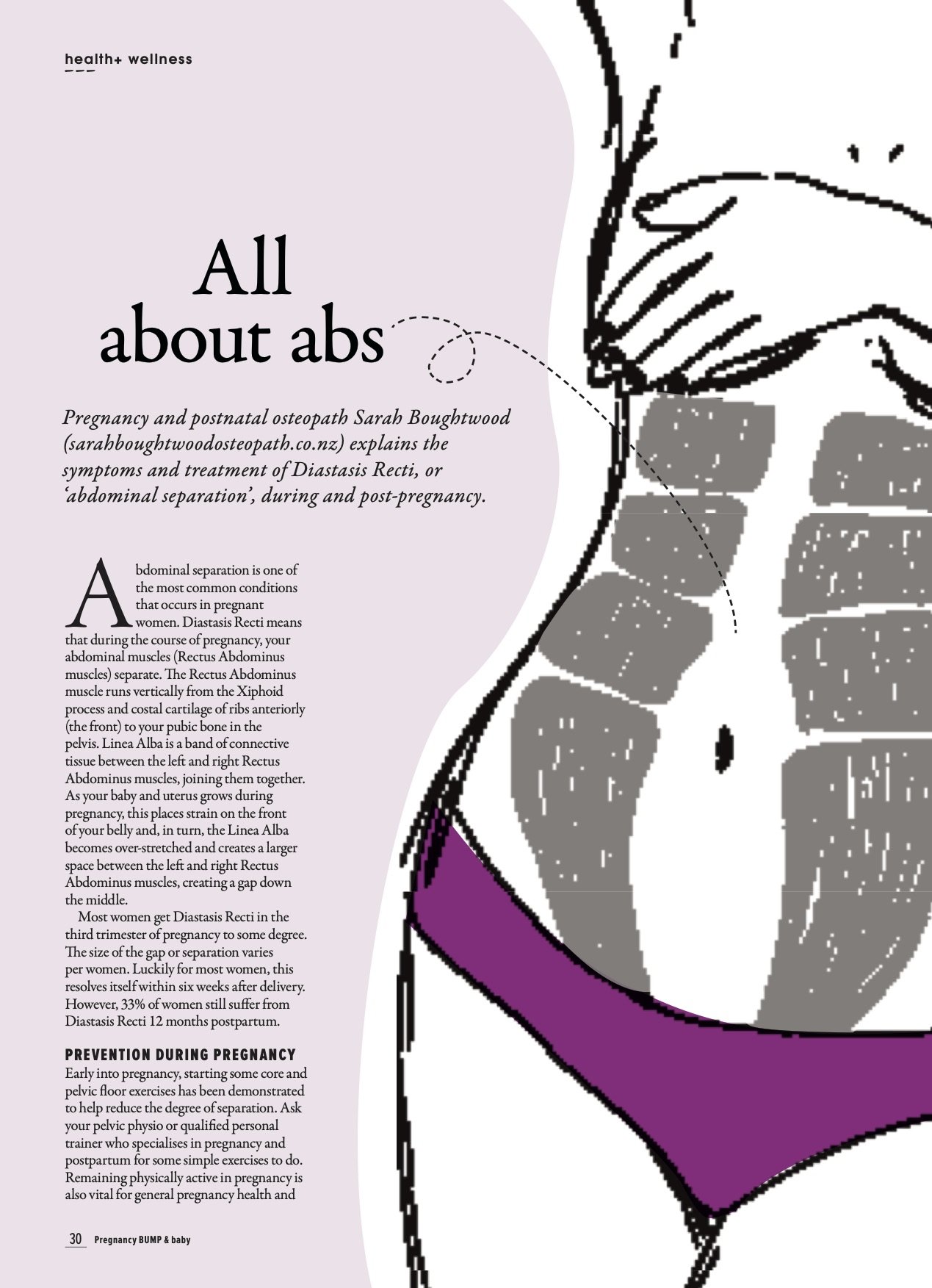Pregnancy, bump & baby - All about the AB’s
What is it?
Abdominal separation is one of the most common conditions that occurs in pregnant women. Diastasis Recti means during the course of pregnancy, your abdominal muscles (Rectus Abdominus muscles) separate. The Rectus Abdominus muscle runs vertically from the Xiphoid process and costal cartilage of ribs anteriorly (the front) to your pubic bone in the pelvis. Linea Alba is a band of connective tissue between the left and right Rectus Abdominus muscles, joining them together. As your baby and Uterus grows during pregnancy, this places strain on the front of your belly and in turn the Linea Alba becomes over stretched and creates a larger space between the left and right Rectus Abdominus muscles, creating a gap down the middle.
Who gets it?
Most women get Diastasis Recti in the 3rd trimester of pregnancy to some degree. The size of the gap or separation varies per women. Luckily for most women, this resolves itself within 6weeks after delivery. However, 33% of women still suffer from Diastasis Recti 12months postpartum.
How do I prevent it?
Early into pregnancy, starting some core and pelvic floor exercises has been demonstrated to help reduce the degree of separation. Ask your pelvic physio or qualified personal trainer who specialises in pregnancy and postpartum for some simple exercises to do. Remaining physically active in pregnancy is also vital for general pregnancy health and reducing Diastasis Recti. General exercise including walking, pregnancy yoga & pilates, swimming and guided gym sessions are very beneficial during pregnancy and postpartum once you are signed off to return to exercise. Healthy bowel habits, passing stools 1-2 a day is also very important. Being constipated places a large amount of strain on your abdominals. Ask your health professional for advice if you are struggling with constipation. Additionally, try elevating your feet when passing stools as this reduces the strain on your bowel and abdomen. You can also practise breathing with your diaphragm. Place one hand on your upper chest and the other on your belly. Focus on when you breathe in, your belly rises 60% and your upper ribs the remaining 40%. When you breathe out, your belly and ribs shrink back to their original location.
How do I know if I have abdominal separation?
- A visible bugle or ‘doming’ when you do sit up
- Softening around your belly button
How is it diagnosed?
A health care practitioner can feel the gap between the two Rectus Abdominus muscles using their fingers along your belly. Sometimes an ultrasound is used the diagnose the Diastasis Recti to see the extent of the separation. A gap bigger than 2cm is considered Diastasis Recti.
What do I need to careful of?
There are certain movements and exercises you need to be careful with and avoid.
- Sit ups or crunches
- Plank or push up unless modified by a health professional
- Double leg lifts
- Heavy lifting
- Sitting straight up when getting out of bed
What can I do to fix it?
Early into pregnancy start some pelvic and core exercises to maintain their strength and support.
Maintain a healthy pregnancy weight
Support healthy bowel movements by fibre in your diet, water, using a foot stool when passing a poo, eating kiwifruit
Avoid heavy lifting
Engage your core gently and bend from the knee’s when you are lifting food shopping, children etc
Roll on to your side and push up with your arms when getting out of bed
Ask your health professional about an abdominal soft brace like tubi grip to wear over your belly
When to ask for help?
For some women the separation is small, and they don’t even notice it, for other women it can cause or be part of the other aches and pains. The abdominal muscles in combination with the diaphragm, pelvic floor and back muscles create your core strength. When this is compromised you might experience; back pain, pain during sex, urinary incontinence, pelvic pain, hip pain or an umbilical hernia. As an Osteopath I always recommend a check-up after birth, this may be with myself or ideally myself and a pelvic physiotherapist. Osteopaths can help check the body after birth, guide you back in to exercise when it is appropriate and help with any new aches and pains that can come with motherhood. These might include; sore neck, shoulders, back relating feeding, lifting, carrying your newborn, birth trauma and so on. An Osteopath can also refer you to a specialist if needed regarding your Diastasis Recti. Most women do not need to see a specialist but in rare occasions surgery might be needed.
Sarah Boughtwood
Pregnancy and Postnatal Osteopath
Milford, Auckland
@sarahboughtwoodosteopath
www.sarahboughtwoodosteopath.co.nz


